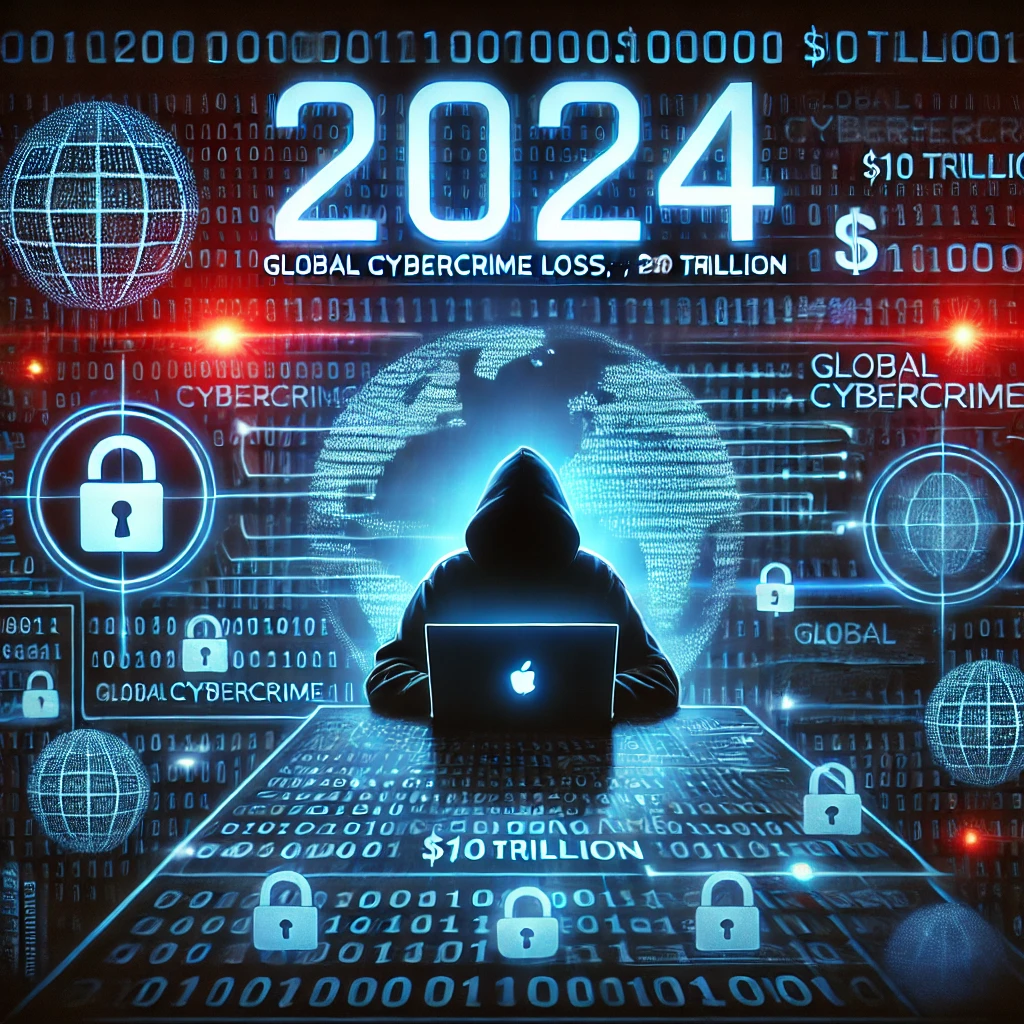Top 10 Cybercrime Cases of 2024
Shocking Realities of 2024: A Record-Breaking Year
2024 is almost finished and is ending in a couple of days. During this year the world has witnessed an unprecedented rise in cybercrimes. Top 10 cybercrime cases of 2024 included sophisticated ransomware attacks, state sponsored hacking, and AI-driven cyber scams. The impacts of these attacks have impacted financial, emotional, and social effects. Globalliy total financial impact of cybercrime in 2024 has been recorded over $10 trillion. Alone ransomware has contributed over $1.2 trillion to this total figure.
All different sectors of industry were targeted. Even the vulnerabilities in healthcare systems and automotive technologies were also exploited. Below are top 10 cybercrime cases of 2024 that explains the gravity of the cybercrime and the immense challenges posed by it.
1. MGM Resorts Ransomware Attack
Impact: $50 million ransom paid, $100 million in operational losses
MGM Resorts is an international hotel chain. It has 31 different hotels and casinos worldwide. In a brutal attack, hackers seized operations of MGM Resorts. They targeted every operation of the hotel from check-ins to casino machines were paralyzed. The attackers of Scattered Spider group, used social engineering (e.g phishing, fraudulent emails, malwares e.t.c) to enter into the system. Although MGM paid the ransom amount of $ 50 million, but its reputational damage exceeded the ransom amount itself. This has marked it as a textbook case of how ransomware attacks can crumble a giant corporation.
2. Change Healthcare Breach
Impact: $22 million ransom paid, $400 million in damages
Change healthcare is a USA based international service provider for healthcare providers, payers and patients. It is running its operations in USA, UK, New zealand, Israel, Taiwan, Canada, and Philippines. On February 21, 2024 one of the most devastating healthcare breaches of the year was launched. Hackers targeted Change Healthcare’s critical systems, which resulted in disrupting patient services across the U.S. As a result of the attack sensitive medical records of the patients was leaked. After payment of $ 22 million on March 18 2024, the company restarted its partial operations. It resulted into several lawsuits and trust issues against the organization, which resulted in around $400 million damages in total.
3. MOVEit Data Theft
Impact: Over $300 million in damages
MOVEit Transfer is widely used file transfer software which enables consolidation of files at one single place for better management and control of core business processes. It came under the limelight when it was hit by a global cyberattack in May 2024. The Clop ransomware group exploited a zero day vulnerability and stole sensitive data from thousands of organizations worldwide.
There are different reports about ransom demands. To avoid public backlash many organizations quietly negotiated the final deal. Therefore, different people reported about payment of ransomware to be between $2 million and $10 million in the form of cryptocurrency. However, estimated total damages exceeded $300 million.
4. Synnovis NHS Cyberattack
Impact: £40 million ransom demanded, £150 million recovery costs
In August 2024, Synnovis, which is a key diagnostic services provider of the UK’s National Health Service (NHS), faced a ransomware attack. The attack disrupted their laboratory operations. The internal email accounts of the organizations were hacked by the perpetrators through a phishing campaign.
NHS refused to pay the ransom of £40 million to the hackers. Synnovis restored its system through their robust backup mechanism. This was a time taking process due to their emergency recovery efforts and legal actions, total cost of losses is approximately £150 million. As a result of this attack their patients faced delayed test results.
5. Lazarus Group’s Cryptocurrency Robbery
Impact: $1.34 billion stolen
A North Korean hacking group ‘Lazarus’ carried out a series of coordinated cryptocurrency robberies in the year 2024. They targeted different crypto exchanges and decentralized finance (DeFi) platforms. The most significant breach occurred in July 2024, where they stole $500 million ‘Ethereum’ (second largest cyrptocyrrency after bitcoin).
All together, the Lazarus Group managed to steal $1.34 billion by November 2024. So far this robbery is one of the largest financial cybercrimes in the history. It is presumed that stolen money may be used to fund North Korea’s weapons program which has raised international security concerns.
6. Microsoft Cloud Email Breach
Impact: Undisclosed damages but it has significant global repercussions.
In April 2024, a state sponsored group exploited vulnerabilities in Microsoft’s cloud email systems. This breach enabled the hackers to access sensitive communications of government and corporate organizations. Microsoft cloud was considered to be a secure cloud system but, this breach proved the loopholes in widely trusted cloud services.
Although the incident had no direct ransom demands; yet, the breach resulted in heavy recovery costs. The attack has caused severe damage to the reputation of Microsoft. Affected organizations have claimed millions of Dollars losses but exact amount of ransom was not disclosed by any organization.
7. CDK Global Ransomware Attack
Impact: $50 million ransom demanded, $200 million in losses
CDK Global is a critical software provider for the automotive industry. It suffered a ransomware attack in June 2024. They had no mechanism of regular updation; therefore, hackers exploited vulnerabilities of outdated software to disrupt its operations across North America.
A ransom demand of $50 million was made on June 15, 2024; but, CDK Global chose to rebuild its system. This decision caused a downtime and loss of $200 million in the form of operational losses. This decision of CDK has shown resilience that is required to resist cyberattacks without paying ransoms.
8. Tesla Driverless Car Attack
Impact: $1 billion in losses
In October 2024, Tesla’s driverless driving software was attacked by cybercriminals. They exploited the vulnerability in its Over-the-Air (OTA) update mechanism. As a result of this attack hundreds of vehicles were remotely disabled, this caused sudden panic among users.
Tesla did not pay any ransom to the hackers. However, the attack caused $1 billion loss to the company in form of lawsuits, revoking the cars, and loss of market trust. The incident raised alarms about the security of AI based technologies in consumer products.
9. AI-Powered Phishing Campaigns
Impact: $900 million stolen globally
In the year 2024, cybercriminals used AI to create highly convincing phishing campaigns. Cybercriminals targeted global businesses and individuals worldwide.
The most notable attack occurred in September 2024, in which global financial institutions were targeted. The campaigns deceived victims through fraudulent messages to transfer funds. AI-powered phishing campaigns have resulted in stealing $900 million globally by the end of the year. The quantum of AI-powered attacks reveals that how can AI amplify the scale and effectiveness of traditional cybercrime techniques.
10. Nigerian Oil Sector Malware Attack
Impact: $750 million in damages
In May 2024, Nigeria’s oil industry became a victim of a malware attack. The attack targeted control mechanism of the industry. The attackers are suspected to be a part of a financially motivated group who disrupted production and supply chain.
The attack caused $750 million damages to the industry. However, there is no confirmation of any ransom payment. The financial losses highlight the need for improvement in cybersecurity in critical infrastructure.
Lessons Learnt from Top 10 Cybercrimes of 2024:
The scale of cybercrime in 2024 has identified following alarming trends:
- AI is a Double Edge Sword: While AI has been proved to be helpful in improvement of cyber security, it has also enabled cybercriminals to carry out more sophisticated and convincing attacks.
- Critical Infrastructure Under Attack: As discussed above, critical infrastructures like healthcare and oil sectors have been attacked. We may say that cybercriminals are targeting the backbone of modern economies.
- Urgent Need for Collaboration: All the stakeholders including governments, industries, and cybersecurity experts must work together to design strong systems.
Way Forward:
As we are ready to step into 2025, the lessons from these cases highlight need for global efforts to build stronger defense mechanism against modern cyber threats. We are way ahead of thinking that “if” a cyberattack occurs. We are at a point to plan what to do “when” a cyberattack occurs. In this regard educating the users, investment in cybersecurity, and international collaboration are best measures against persistent war against cybercrime.





Good research work